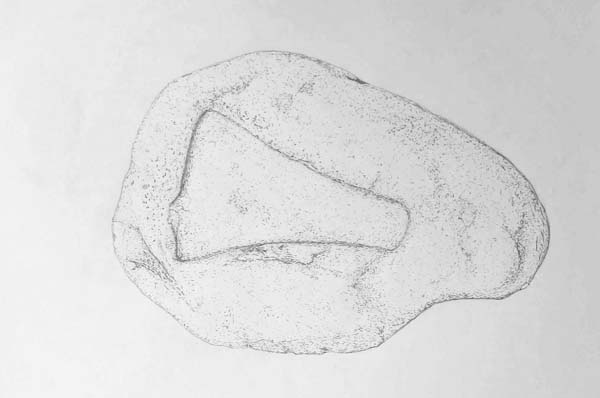Stone Axe-head Mould

Drawing of the original axe-head mould
The Dales Countryside Museum in Hawes asked if I would make a replica stone axe-head mould. They sent me this archaeological drawing of one they had on loan, along with measurements so that I could carve a copy in stone. The moulds were also made in clay or sand.
Axes first came into use over a million years ago. Initially, they were hand-held tools made entirely of flint, greenstone or slate, with no handle. Eventually man learned to attach the axe head to a handle for more power. One breakthrough of the Bronze Age, c. 3000-500 BC, was bronze or copper axes, which started replacing stone axes. To start with, the design was a pure reproduction of the stone axe. The axes were a tool and also luxury weapons or ceremonial objects.

Stone carved copy of axe-head mould
After a while, moulds were also made for the axe heads, so that axes could start being copied and, to some extent, mass-produced. The axe changed again during the Iron Age, the handleless axes disappeared, to be replaced by axe heads with a hole for the handle. The axes also became larger, with broader blades.
Metal working was a complex and lengthy process. A small pit was dug, filled with crushed ore and charcoal, and then ignited. The temperature was raised by using bellows, perhaps made of animal skin. Once smelting had occurred the molten metal was collected in a crucible and tipped into the mould. After cooling the casting was removed and hammered to smooth any rough edges. Cutting edges on axe heads would have been sharpened by hammering or grinding. When stone moulds were in use, shapes tended to be simple, but about 3,500 years ago multiple section clay moulds were developed which enabled more complicated shapes to be made.

Early Bronze Age metal workers used pure copper, but this made objects which were flexible in use and difficult to cast. After a period of experimentation, bronze, an alloy of 90 per cent copper and 10 per cent tin was developed.
The stone originally used for the mould was likely to have been chosen from a river pebble, a stone which was smooth and flattish. This is a very early and simple axe-head – the mould being a single open piece – there is no hafting socket, strengthening ridges or flanges and it would have required a lot of honing and finishing once cast. It looks (from the drawing) as though at some stage the cast has been forced out of the mould and broken the stone edge at the blade end.

My replica looks strangely new. It would be good if the Museum have some way of aging it so it fits well in their pre-history resource display. Perhaps it just needs the wear and tear of a few axe-heads casting in it.
